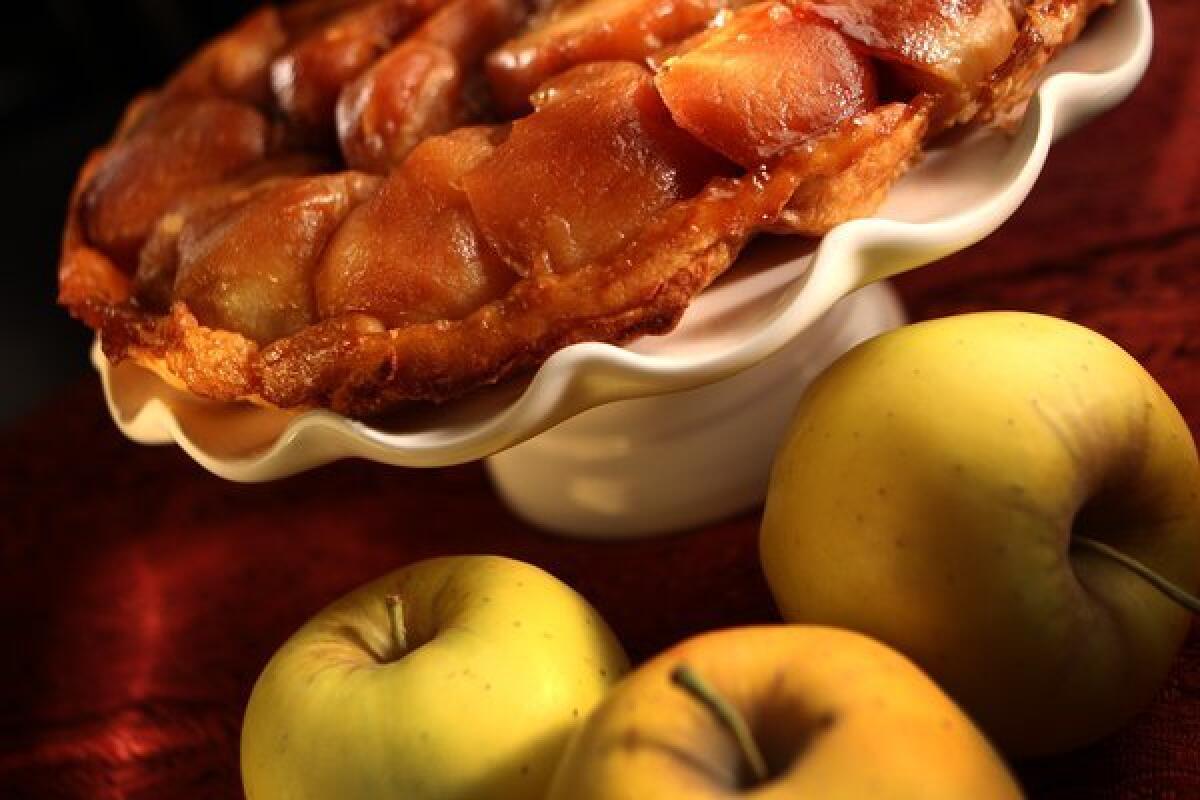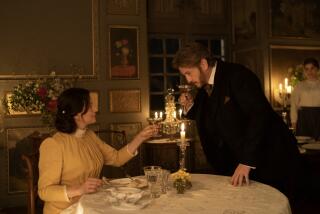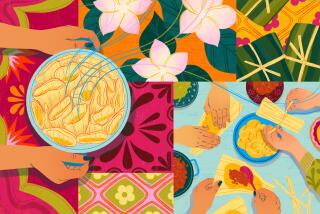Across the Table: In Paris, falling in love with <i>tarte Tatin</i>

- Share via
When I was in my 20s, studying wine and living on very little money in Paris, I couldn’t afford to eat in real restaurants very often. But I’d stop at a favorite wine bar a couple of times a week. It always seemed to be cold weather, and the chill crept through the soles of my boots. To warm up, I would nurse a single glass of Chinon or Bourgeuil with a tartine (open-faced sandwich) or dark-flecked Poilâne bread with a crottin of goat cheese smashed on top.
I can remember looking longingly at the end of the zinc bar where a tarte Tatin inevitably would be set out in all its glory, the apples satiny and glistening with caramel. I could imagine the slightly jelled texture of the apples, the warm buttery taste of the caramel against a dollop of thick ivory crème fraîche. Essentially an upside-down tart, the crust is baked on top of the apples and the tart is inverted to serve.
Most of the time, though, I couldn’t afford it. Or even the small cup of coffee I envisioned enjoying after. So when I did finally get my tarte des demoiselles Tatin, referring to the two spinster sisters who invented it (on purpose or no) at their family hotel in the Loire Valley of France, it tasted all the sweeter.
I treasure that memory of eating a warm tarte made with new crop apples, the windows of the wine bar or bistro steamed up, the blue-gray of November or December outside. And years later, on a subsequent trip to France, when I had more money in my pocket, I marched right into the cookware shop Déhillerin and accosted one of their famously grouchy clerks: “I would like to buy a proper tarte tatin pan”.
I ended up splurging on two heavy copper pans (what can I say? the dollar was strong), one about the size of a 9-inch tart pan with 2-inch sides and tiny copper “ears,” and the other a generous 13 inches in diameter. I guess because it reminded me of those big tartes I’d seen at the wine bars.
I’ve been happily making tarte Tatin ever since, mostly in the smaller pan but occasionally in that grand one, which will serve 10 and counting. When I rented a house near Joshua Tree with friends last year, I even managed on an electric stove, using a wine bottle to roll out the pastry.
I love standing by the stove, keeping watch as the butter and sugar mixture caramelizes. It sputters up between the wedges, sending the smell of burnt sugar and apple through the entire house.
I’ve tried lots of recipes and eventually worked out the simplest. Not for me the usual puff pastry. I make mine with a classic pâte brisé, which takes just minutes to make.
After I tried New York chef Jean-Georges Vongerichten’s version, I no longer even make the caramel first. His method (detailed in his book “Home Cooking With Jean-Georges”) works just as well. He basically smooshes the butter together with the sugar, spreads it out in the bottom of the pan and arranges the tightly packed apples on top. Then he turns the fire on high and waits for butter and sugar to caramelize. Caution: If the flame is too low, the apples will start giving up their juice before the caramelization takes place and it will be hard to get that characteristic deep amber color.
Note too that you don’t have to use a copper pan. A cast-iron pan (or any heavy skillet that can go into the oven) works just as well.
Choosing the right apple is important. The usual is Golden Delicious, which is available almost everywhere. Granny Smith works well too. Do investigate the old varieties at the farmers market. Ask the vendor which of them make great baking apples. Some come into season for only a few weeks, but you should be able to find Braeburn or Cox. I can never remember which ones I tried when, but I do recall liking a tarte made with Black Arkansas apples I found at the Santa Monica farmers market one year.
It takes close to 5 pounds of apples to make a 9-inch tarte Tatin (the apples shrink as they cook). Even so, I find it pays to use the larger pan. The leftovers are wonderful the next afternoon with a freshly brewed cup of coffee.
More to Read
Eat your way across L.A.
Get our weekly Tasting Notes newsletter for reviews, news and more.
You may occasionally receive promotional content from the Los Angeles Times.










